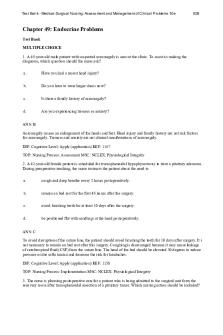Chapter 11 Summary Endocrine PDF

| Title | Chapter 11 Summary Endocrine |
|---|---|
| Author | Xong Lor |
| Course | Anatomy and Physiology |
| Institution | Carrington College |
| Pages | 1 |
| File Size | 33.4 KB |
| File Type | |
| Total Downloads | 105 |
| Total Views | 160 |
Summary
chaper notes...
Description
Xong Lor Chapter 11 Summary - Endocrine System The endocrine system communicates and control the body, but in a slower and longer-lasting type of control compared to the nervous system. The endocrine organs secrete chemical (hormones) into the intercellular spaces and travel through the blood stream to affect areas in the body. Hypersecretion is when too much hormone is secreted whereas hyposecretion is when too little hormone is secreted. There are two major types of hormones: nonsteroid and steroid. Nonsteroid hormones are first messengers; they bind to receptors located on the cell membrane, triggering the second messenger to affect the cell’s activity. Steroid hormones pass through the cell membrane, cytoplasm, and enter the nucleus where they bind with a receptor. Hormone secretion is controlled by homeostatic feedback. Negative feedback is when the mechanism reverses the direction of a change in a physiological system. Positive feedback is when the mechanism amplifies the physiological change. The pituitary gland has two structures: the anterior and posterior pituitary glands. The posterior pituitary gland secrets antidiuretic hormone (ADH) and oxytocin. ADH causes water reabsorption from urine, decreasing urine secretion. Oxytocin stimulates the uterus to contract during labor. The anterior pituitary gland secrets thyroid stimulating hormone (TSH), follicle stimulating hormone (FSH), luteinizing hormone (LH), and growth hormone (GH). The thyroid gland secrets thyroxine (T4) and triiodothyronine (T3) which increases metabolism. The thyroid also secrets calcitonin, which decrease the blood calcium concentration by inhibiting the breakdown of bone. On the other hand, the parathyroid glands secrets hormones when there is a low level of calcium in the blood. It breaks down bone matrix to increase calcium level. The adrenal glands are located on the superior surface of the kidneys. It is comprised of 2 parts, the adrenal medulla (center) and the adrenal cortex (outer portion). The adrenal medulla secrets epinephrine (adrenaline) and norepinephrine. It stimulates the sympathetic nervous system (fight or flight). The adrenal cortex has 3 zones or layers. The inner zone secretes sex hormones. The middle zone secretes glucocorticoids, which plays an essential part in maintaining blood pressure and blood glucose. The outer zone secretes mineralocorticoids (aldosterone) which plays a role in kidney reabsorption. The pancreatic islets of the pancreas are small clumps of cells. The alpha cells of the pancreatic islets secretes glucagon which increases blood glucose level by accelerating liver glycogenolysis, the conversion of glycogen to glucose. The beta cells of the pancreatic islets secrets insulin, which decreases blood glucose by accelerating the movement of glucose into cells. Type 1 diabetes mellitus is when the pancreatic islets secrete too little insulin. Type 2 diabetes mellitus is when there is an abnormality of the insulin receptors, causing insulin resistance. Diabetes insipidus is when there is a hyposecretion of antidiuretic hormone (ADH), which does not allow the kidney to retain water in the body, causing polyuria....
Similar Free PDFs

Chapter 11 Summary Endocrine
- 1 Pages

Chap 11 Endocrine System
- 3 Pages

Chapter 11 Summary
- 3 Pages

Chapter 11 Summary
- 1 Pages

kaplan Review Summary-endocrine
- 4 Pages

Endocrine System Summary
- 7 Pages

Microeconomies summary chapter 2-11
- 34 Pages

Endocrine
- 73 Pages

Chapter 49 Endocrine Problems
- 20 Pages

Endocrine
- 17 Pages

Chapter 7 the endocrine system
- 18 Pages
Popular Institutions
- Tinajero National High School - Annex
- Politeknik Caltex Riau
- Yokohama City University
- SGT University
- University of Al-Qadisiyah
- Divine Word College of Vigan
- Techniek College Rotterdam
- Universidade de Santiago
- Universiti Teknologi MARA Cawangan Johor Kampus Pasir Gudang
- Poltekkes Kemenkes Yogyakarta
- Baguio City National High School
- Colegio san marcos
- preparatoria uno
- Centro de Bachillerato Tecnológico Industrial y de Servicios No. 107
- Dalian Maritime University
- Quang Trung Secondary School
- Colegio Tecnológico en Informática
- Corporación Regional de Educación Superior
- Grupo CEDVA
- Dar Al Uloom University
- Centro de Estudios Preuniversitarios de la Universidad Nacional de Ingeniería
- 上智大学
- Aakash International School, Nuna Majara
- San Felipe Neri Catholic School
- Kang Chiao International School - New Taipei City
- Misamis Occidental National High School
- Institución Educativa Escuela Normal Juan Ladrilleros
- Kolehiyo ng Pantukan
- Batanes State College
- Instituto Continental
- Sekolah Menengah Kejuruan Kesehatan Kaltara (Tarakan)
- Colegio de La Inmaculada Concepcion - Cebu




